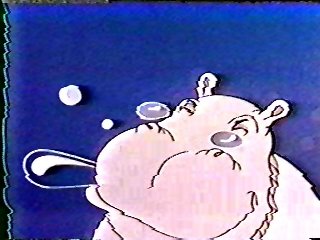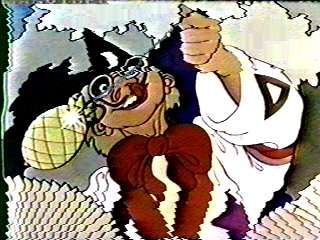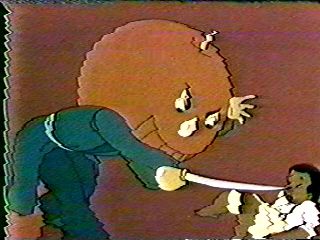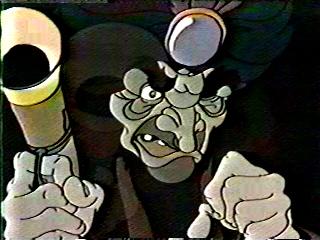
|
|
|
|
|
|
|
|
|
|
|
|
|
(1976) Director: William
Feigenbaum
Throughout cinematic history, there have been a large number of failures in movie-making as there have been a large number of successes, though it's probably safe to say that the number of the former is higher. Each failure can't help but be unique in its own way, having its own cast of characters involved in it, for one thing. And usually also because each failure ultimately happened because of more than one thing that went wrong along the way - either in unforeseen ways, or for someone's ineptness. But there are a few examples of failures that occurred because of one root cause, happing so early in the game that there was no possible way the movie could ever find a way to lift itself up and succeed. For instance, take the fate of RKO studios. Any Hollywood historian will tell you that the reason the studio came to a painful end was because Howard Hughes bought it in 1948; four years later, the studio had only a quarter of the employees it had before Hughes started running things. But a one root cause isn't just limited to studios, but can also be seen in the movies the studios put out. We've all seen movies that would have worked well had it not been for a miscast actor... a strident musical score... incompetent direction... or even a botched special effect, if said effect is really important to the plot. In the case of Hugo The Hippo, however, the blame for its failure did not necessarily come from a lack of talent or ability in any field. Who knows, the people who made it may very well have come up with a passable movie had it not been for one thing that got in their way early in the game.... Drugs. That's the first and most likely theory to explain the
craziness that you see before your eyes in Hugo The Hippo.
Sure, you can point out But drugs or no drugs... my God! How can I describe this living oxymoron, that being a real hallucination? Where to start? How about with the Marie Osmond-sung opening song: Do you know the way to tell a story that's true A story so strange no one could ever make it up has
to be true Drugs, no doubt about it. In Ms. Osmond's case, given her background, it had to be peyote. It's actually a double dose of the bizarre during this sequence, because while we are listening and trying to comprehend this song, we are getting a first glimpse of the art design and animation of the movie. Like the song, it renders you almost worldless, and you struggle to best describe the impression it makes. What will first come out of the lips of most people will no doubt be "Yellow Submarine". Certainly, that movie gave this movie's artists and animators great inspiration. But while the artwork in Yellow Submarine was surreal and wildly colored, it still remained extremely clear to the audience. As exaggerated as the characters looked, they stood firm individually and from each other, and did not clash with the background. In the case of Hugo The Hippo, it resembles what Yellow Submarine inspired. What am I talking about? Well, go to any used book store, and dig up some books printed in the 1970s, specifically books that have cover art that was inspired by Yellow Submarine. I think now you know what I'm talking about: People and objects (often in front of a completely white background) drawn as being made up of dozens of murky-colored curvy "blobs", each blob having a thin black line around it that was drawn seemingly with a shaky hand. It's not unusual if some of these multi-shaped "blobs" aren't even colored in. Seen today, such artwork has a curiously depressing feeling to it - like it was drawn by someone coming out of a bad "trip". While it could be argued that this particular style of
psychedelic art could make for some But the most bizarre aspect to be found in Hugo The Hippo isn't with its art style, though it sure runs close. It's the screenplay that's utterly mad, constantly coming up with situations and chance occurrences that have little to no resemblance to anything in real life... coming across even stranger because of those druggie individuals holding the brushes and pens. The story starts off the coast of Africa on the island of Zanzibar. The island is starting to prosper from the cloves it ships out, though the shallow harbor means that the bundles of cloves must be placed by workers wading far out to the anchored ships. Work is disrupted one day by the arrival of the cast of the aquatic version of Cruising - cap-wearing sharks decked out with biker jewellery attack the workers. Though the sharks aren't actually seen ripping into the workers, the kiddies will get the idea with the subsequent montage of sharks smashing against the workers with great force, and one shot of a closed-mouth shark chewing with great force. When the Zanzibar minister of law and finance comes by and observes the chaotic scene, he initially doesn't understand why everyone is so frightened by these kinky-looking sharks. This may be explained by the fact the minister is voiced by Paul Lynde, though this doesn't explain why he expresses fear and turns tail when the sharks get a hold of him and strip him nearly naked. With the clove trade on hold because of these sharks, what can be done? The Sultan (voiced by Robert Morley) correctly figures out that digging a deeper bay so the ships can anchor closer to shore would be costly and time-consuming. Though it's funny how the logical idea of building piers never comes up, or the idea of using small vessels that could sail in shallow waters. Anyway, that night the Sultan looks to the heavens above for inspiration, and the thousands of tiny lights give him the answer - hippos! Why not; it's well known how the mighty river-dwelling hippo can more than hold its own against any salt water shark. So the Sultan sends the minister with a party to the mainland to capture hippos, which is accomplished when the party's magician conjures up a lasso-throwing mechanical cowboy/horse robot that's twice as big as a tyrannosaurus rex. (Don't ask - and don't ask why the magician didn't use his fantastic powers directly on the sharks.) Hugo escapes, but later decides to tag along with his captured comrades, who do indeed manage to rid Zanzibar harbor of sharks. Not needed anymore, they soon become pests, and the minister decides to shoot them all. Possibly to not make the slaughter too traumatic for the kids, this is pictured as clouds shaped as hippos being struck by lightning. Though we are subsequently shown the actual bodies of all the hippos (save Hugo) lying dead at the bottom of the sea, care was taken to show Hugo crying at this sight in a passive manner, so kids won't be upset by it, nor the fact he's now alone and a fugitive. By now you should have an idea that Hugo The
Hippo goes far beyond being a misguided (in more than one way)
animated movie; it is seriously And Jimmy Osmond also takes peyote, judged by the following song he sings: He walks like an elephant, To be fair, not everything in Hugo The Hippo
is deranged or absolutely incomprehensible. While the rest of the songs
in the movie (including those two previously The movie poster for Hugo proclaimed, "Color, creatures, music, sound like you've never seen or heard before. It's the wildest trip ever animated. It's a treat for the whole family. It's PHANTASMAGORICAL!" Almost, but not quite correct. So even the advertising executives stumbled while working on the movie. Unless the family they were talking about was the Osmond family. Check
for availability on Amazon (VHS) See also: Escape To Grizzly Mountain, The Last Unicorn, Pinocchio In Outer Space |
 that the movie was made in
Hungary, while the Iron Curtain was up and still holding
firm. But you have to remember that the Hungarians were
more vocal about the oppressive rule, such as with the revolution they
instigated in 1956. Many of the protesters were students. Students in
the U.S. a decade later protested their own government, and we all know
they were on drugs. Therefore, a drug culture must have existed in
Hungary at one time. Now, I will admit there are other possibilities
that may explain the bizarreness. There is always the possibility that
the movie was made through a Hungarian viewpoint, and that you'd have
to use such a viewpoint to appreciate it. And there is also the
possibility that at the time it was made, the "bizarreness" would have
been considered normal. This kind of thing has happened many times in
the past, even in animation. I recall an especially stylized Captain
Crunch commercial a few years back, with the Captain driving down a
street in a long Cadillac-like car equipped with hydraulics that were
making the car's front end bounce up and down while a rap song was
playing. At the time, I couldn't help but think how dated and
subsequently ridiculous the commercial would look to people in the next
decade. (Perhaps it was already silly, since I also recall that at the
same time I was rolling around on the floor, and not in agony.)
that the movie was made in
Hungary, while the Iron Curtain was up and still holding
firm. But you have to remember that the Hungarians were
more vocal about the oppressive rule, such as with the revolution they
instigated in 1956. Many of the protesters were students. Students in
the U.S. a decade later protested their own government, and we all know
they were on drugs. Therefore, a drug culture must have existed in
Hungary at one time. Now, I will admit there are other possibilities
that may explain the bizarreness. There is always the possibility that
the movie was made through a Hungarian viewpoint, and that you'd have
to use such a viewpoint to appreciate it. And there is also the
possibility that at the time it was made, the "bizarreness" would have
been considered normal. This kind of thing has happened many times in
the past, even in animation. I recall an especially stylized Captain
Crunch commercial a few years back, with the Captain driving down a
street in a long Cadillac-like car equipped with hydraulics that were
making the car's front end bounce up and down while a rap song was
playing. At the time, I couldn't help but think how dated and
subsequently ridiculous the commercial would look to people in the next
decade. (Perhaps it was already silly, since I also recall that at the
same time I was rolling around on the floor, and not in agony.) good drawings or
paintings, this extreme style is completely wrong for an animated
movie. When this art style is in a sense a snapshot, you can take the
time to properly study it. Your brain can piece together all those
hundreds of pieces and see and appreciate the artwork as a whole. But
it's a much different situation when you are seeing this in animation.
In an animated movie, you can be seeing 12 or more such snapshots every
second. Not only that, each snapshot is different than the one
preceding it. This gives the impression that the images are
continuously moving. You see the problem now; with the dozens of
"blobs" making up each person or object constantly moving around, it's
hard to get a full grasp of the entire thing the combined "blobs" are
supposed to represent. But that's just one of the problems with this
art style used in an animated format. The other problem is with the
color scheme. While the colors in Yellow Submarine
were bright and helped differentiate everything from each other, all
the colors here look like they were mixed with the same particular
shade of mud. Frequently it makes it even harder to differentiate
things from each other or the backgrounds. Even if care had been taken
to give everything breathing space, the movie still would have
suffered; while there's legitimate argument to sometimes use limited
color in live-action (such as with black and white photography), I
think we can all agree that cartoons look better in (bright) color.
good drawings or
paintings, this extreme style is completely wrong for an animated
movie. When this art style is in a sense a snapshot, you can take the
time to properly study it. Your brain can piece together all those
hundreds of pieces and see and appreciate the artwork as a whole. But
it's a much different situation when you are seeing this in animation.
In an animated movie, you can be seeing 12 or more such snapshots every
second. Not only that, each snapshot is different than the one
preceding it. This gives the impression that the images are
continuously moving. You see the problem now; with the dozens of
"blobs" making up each person or object constantly moving around, it's
hard to get a full grasp of the entire thing the combined "blobs" are
supposed to represent. But that's just one of the problems with this
art style used in an animated format. The other problem is with the
color scheme. While the colors in Yellow Submarine
were bright and helped differentiate everything from each other, all
the colors here look like they were mixed with the same particular
shade of mud. Frequently it makes it even harder to differentiate
things from each other or the backgrounds. Even if care had been taken
to give everything breathing space, the movie still would have
suffered; while there's legitimate argument to sometimes use limited
color in live-action (such as with black and white photography), I
think we can all agree that cartoons look better in (bright) color. warped. I am pretty sure some
children will be disturbed by the art and animation alone, not only
failing to resemble any style they've seen before, but how its jumble
of blobs and faded colors is enough to even make adults shift
uncomfortably around in their seats. Then of course there are touches
in the story that will seriously traumatize the kids, not being just
limited to man-eating sharks and genocide. The parents of the children
who appear later in the movie are portrayed as cruel and thoughtless
monsters who burn and pillage their children's fancy vegetable garden
they planted for Hugo's food supply, and later gather in a mob with
pitchforks and other farm tools crying out for the law to put Hugo to
death. Such sights may not terribly disturb adult viewers, but on the
other hand they will be utterly perplexed by a number of
hallucination-like sights that their kids will more readily accept. We
see a freeway at the bottom of the ocean, with starfish and other
marine life being the speedy traffic. The magician sleeps in a
rolled-up carpet floating in midair. The bottom of the river where the
hippos live contains a hippo amusement park (complete with Ferris
wheels and bumper cars) covered with frosting and candy. An
absent-minded guy unknowingly sticks his fork in a toaster, and doesn't
feel his subsequent electrocution. The magician sets a trap for Hugo
that involves giant corn on the cob tanks and living asparagus soldiers
with swords. Hugo and the human boy he's befriended escape this trap by
jumping on a giant butterfly, who flies up into space and to a
vegetable solar system.
warped. I am pretty sure some
children will be disturbed by the art and animation alone, not only
failing to resemble any style they've seen before, but how its jumble
of blobs and faded colors is enough to even make adults shift
uncomfortably around in their seats. Then of course there are touches
in the story that will seriously traumatize the kids, not being just
limited to man-eating sharks and genocide. The parents of the children
who appear later in the movie are portrayed as cruel and thoughtless
monsters who burn and pillage their children's fancy vegetable garden
they planted for Hugo's food supply, and later gather in a mob with
pitchforks and other farm tools crying out for the law to put Hugo to
death. Such sights may not terribly disturb adult viewers, but on the
other hand they will be utterly perplexed by a number of
hallucination-like sights that their kids will more readily accept. We
see a freeway at the bottom of the ocean, with starfish and other
marine life being the speedy traffic. The magician sleeps in a
rolled-up carpet floating in midair. The bottom of the river where the
hippos live contains a hippo amusement park (complete with Ferris
wheels and bumper cars) covered with frosting and candy. An
absent-minded guy unknowingly sticks his fork in a toaster, and doesn't
feel his subsequent electrocution. The magician sets a trap for Hugo
that involves giant corn on the cob tanks and living asparagus soldiers
with swords. Hugo and the human boy he's befriended escape this trap by
jumping on a giant butterfly, who flies up into space and to a
vegetable solar system. mentioned) are hopelessly bad,
there is one fairly delightful little number - "The Best Day Ever Made"
- boosted by the warm singing voice of the movie's narrator, Burl Ives.
And there is occasionally an animated bit that differentiates itself
enough from the swirl surrounding it that you are impressed; Hugo's
escape from the minister through a stormy sea is one such example. But
such moments do little to change the movie's standing as a joyless
affair. While the animation and music are bad enough, what may be the
worst thing about the movie is that it has no heart. The tone is
constantly harsh and cynical, with little trace of any of the positive
attributes found in humanity. It's even hard to warm up to Hugo
himself. While the title suggests he takes center stage in everything,
the movie seems determined not to develop him as a character. After a
quick glimpse of him in the beginning, he's not seen again for about
half an hour. In just about all of his subsequent appearances from that
point on, he comes across as a boulder with legs, showing no real
personality. The movie seems more interested in people's reactions to
him, not his reactions to what happens around him. If there's
one thing good about this boring hippo, it is that it gives the viewer
a dull but firm anchor for his sanity to latch onto while watching the
movie.
mentioned) are hopelessly bad,
there is one fairly delightful little number - "The Best Day Ever Made"
- boosted by the warm singing voice of the movie's narrator, Burl Ives.
And there is occasionally an animated bit that differentiates itself
enough from the swirl surrounding it that you are impressed; Hugo's
escape from the minister through a stormy sea is one such example. But
such moments do little to change the movie's standing as a joyless
affair. While the animation and music are bad enough, what may be the
worst thing about the movie is that it has no heart. The tone is
constantly harsh and cynical, with little trace of any of the positive
attributes found in humanity. It's even hard to warm up to Hugo
himself. While the title suggests he takes center stage in everything,
the movie seems determined not to develop him as a character. After a
quick glimpse of him in the beginning, he's not seen again for about
half an hour. In just about all of his subsequent appearances from that
point on, he comes across as a boulder with legs, showing no real
personality. The movie seems more interested in people's reactions to
him, not his reactions to what happens around him. If there's
one thing good about this boring hippo, it is that it gives the viewer
a dull but firm anchor for his sanity to latch onto while watching the
movie.